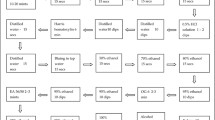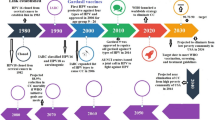Abstract
Objective
Cervical cancer is the commonest cancer among Indian women. High-risk human papilloma virus (HPV) detection holds the potential to be used as a tool to identify women, at risk of subsequent development of cervical cancer. There is a pressing need to identify prevalence of asymptomatic cervical HPV infection in local population. In our study, we explored the prevalence of HPV genotypes and their distribution in women with cervical lesions.
Methods
Scrape specimens were obtained from 100 women (study group) with cervical abnormalities. HPV was detected with amplicor HPV tests, and the individual genotypes in these specimens were identified by Hybribio Genoarray test kit. Fifty specimens were also collected from females with healthy cervix (control group). The present study also aimed to determine the status of HPV prevalence and its association with different sociodemographic factors.
Results
Out of the total number of 100 samples, 10 (10 %) women tested positive for HPV DNA. Among them, HPV 18 was observed in 6, HPV 16 in 2, HPV 52 and HPV 39 in one each. Fifty specimens collected from patients with healthy cervix were not infected with any of the HPV genotype.
Conclusions
Our study generates data of HPV prevalence in patients with cervical lesions visiting tertiary care institute. The data generated will be useful for laying guidelines for mass screening of HPV detection, treatment, and prophylaxis.
Similar content being viewed by others
References
Burd EM. Human papilloma virus and cervical cancer. Clin Microbiol Rev. 2003; 16:1–17.
Braaten KP,Laufer MR. Human papilloma virus (HPV), HPV related disease, and the HPV vaccine. Rev Obstet Gynecol. 2008; 1(1):02–10.
Shanta V, Krishnamurthi S, Gajalakshmi CK, et al. Epidemiology of cancer of the cervix: global and national perspective. J Indian Med Assoc. 2000; 98:49–52
Speich N, Schmitt C, Bollmann R, et al. Human papillomavirus (HPV) study of 2916 cytological samples by PCR and DNA sequencing: genotype spectrum of patients from the west German area. J Med Microbiol. 2004; 53:125–28
Ferlay J, Parkin DM, Pisani P. GLOBOLAN 2002: Cancer incidence, mortality, and prevalence worldwide version 1.0 IARC Cancer Base No. 5. Lyon: IARC press; 2005.
Clifford GM, Gallus S, Herrero R, et al. Worldwide distribution of human papillomavirus types in cytologically normal women in the international agency for research on cancer HPV prevalence surveys: a pooled analysis. Lancet. 2005; 366:991–8.
Forbes BA, Sahm DF, Weissfeld AS. Laboratory methods in basic virology. Bailey and Scott’s diagnostic microbiology. 12th ed. St. Louis: Mosby Elsevier; 2007. p. 729–30.
Munoz N, Bosch FX, de Sanjose S, et al. Epidemiologic classification of human papilloma virus types associated with cervical cancer. N Engl J Med. 2003; 348: 518–27.
Jastreboff AM, Cymet T. Role of the human papilloma virus in the development of cervical intraepithelial neoplasia and malignancy. Postgrad Med J. 2002; 78:225–8.
Stanley M. Genital human papillomavirus infections and prospective therapies. J Natl Cancer Inst. 2003; 31:117–24.
Rozendaal L, Walboomers JM, van der Linden JC, et al. PCR-based high-risk HPV test in cervical cancer screening gives objective risk assessment of women with cytomorphologically normal cervical smears. Int J Cancer. 1996; 68:766–9.
Sherman ME, Lorincz AT, Scott DR, et al. Baseline cytology human papillomavirus testing and risk for cervical neoplasia: A 10 -year cohort analysis. J Natl Cancer Inst. 2003; 95:46–52.
Walker JL, Wang SS, Schiffman M, et al. ASCUS LSIL Triage Study Group. Predicting absolute risk of CIN3 during postcolposcopic follow-up: results from the ASCUS-LSIL Triage Study (ALTS). Am J Obstet Gynecol. 2006; 195:341–8.
Bhatla N, Dar L, Patro AR, et al. Human papillomavirus type distribution in cervical cancer in Delhi, India. Int J Gynecol Pathol. 2006; 25:398-402.
Kerkar SC, Latta S, Salvi V, et al. Human papillomavirus infection in asymptomatic population. Sex Reprod Health. 2011; 2:7–11.
Sowjanya AP, Jain M, Poli UR, et al. Prevalence and distribution of high-risk human papilloma virus (HPV) types in invasive squamous cell carcinoma of the cervix and in normal women in Andhra Pradesh, India. BMC Infect Dis. 2005; 5:116.
Franceschi S, Rajkumar T, Vaccarella S, et al. Human papillomavirus and risk factors for cervical cancer in Chennai, India: A case-control study. Int J Cancer. 2003; 107:127–33.
Kim SJ. Role of colposcopy and cervicography in screening and management of precancerous lesions and early invasive cancer of uterine cervix. J Obstet Gynecol. India 2000;50:134–46.
Peedicayil A, Abraham P, Sathish N, et al. Human papillomavirus genotypes associated with cervical neoplasia in India. Int J Gynecol Cancer 2006;16:16(4):1591–5.
Duttagupta C, Sengupta S, Roy M, et al. Are Muslim women less susceptible to oncogenic human papillomavirus infection.A study from rural eastern India. Int J Gynecol Cancer. 2004;14:293–303.
Aggarwal R, Gupta S, Nijhawan R, et al. Prevalence of high-risk human papillomavirus infections in women with benign cervical cytology: a hospital based study from North India. Indian J. Cancer. 2006;43:110–16.
Verteramo R, Pierangeli A, Calzolari E, et al. Direct sequencing of HPV DNA detected in gynaecologic outpatients in Rome, Italy. Microbes Infect. 2006;8: 2517–21.
Datta P, Bhatla N, Dar L, et al. Prevalence of human papillomavirus infection among young women in North India. Cancer Epidemiol. 2010;34:157–61.
Lazcano-Ponce E, Herrero R, Munoz N, et al. Epidemiology of HPV infection among Mexican women with normal cervical cytology. Int J Cancer. 2001; 91:412–20.
Author information
Authors and Affiliations
Corresponding author
Rights and permissions
About this article
Cite this article
Kaur, P., Aggarwal, A., Nagpal, M. et al. Prevalence and Clinical Utility of Human Papilloma Virus Genotyping in Patients with Cervical Lesions. J Obstet Gynecol India 64, 279–283 (2014). https://doi.org/10.1007/s13224-014-0508-5
Received:
Accepted:
Published:
Issue Date:
DOI: https://doi.org/10.1007/s13224-014-0508-5




